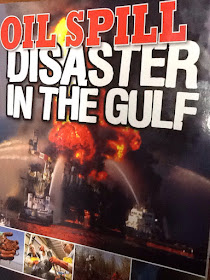Can I just say HALLELUJAH that our second round of state testing is finally over?
When we test in the morning, I've been making a special effort to make our afternoons very interactive and fun. Tuesday, we did that through some themed learning about sea turtles and oil spills!
We started out on Monday reading a book I love- and picked up with a CD from Amazon for $6 a few years ago, One Tiny Turtle. I will warn you that it talks a lot about the dangers facing sea turtles, which means only ONE tiny turtle survives.
This is a good time to remind students that predators aren't mean (they're just hungry too) and explain that this is why sea turtles lay so many eggs. I also take this opportunity to tell them about the sea turtle farm I visited on vacation once, and talk about how they're helping more babies survive, so we leave it on a happy note!
This book has a narrative PLUS sea turtle facts, and gooorgeous illustrations. (Sorry for iPad photos- I promise, the illustrations are beautiful!
So we read this book aloud- once for the narrative, once for the facts- and then it's in our listening center for the week.
The next day, when we read about oil spills in this book, we connected the two stories together.
This is a Scholastic book club find... Totally terrific informational text!
After reading part of it, my kids were able use their knowledge from One Tiny Turtle to explain how sea turtles in various parts of their life cycle would be affected by an oil spill. THIS is real, meaningful text-to-text connection!
So then, before reading the parts about how oil spills are cleaned up, we tried to see what the big deal was.
We first studied oil and water, and how they don't mix, as a class. Then, each group got their own "ocean" with an oil spill, and I let them brainstorm how to clean it up.
We tried sponges...
We tried using a straw to make a barricade...
We tried cups...
We tried paper towels...
At the end, I let the groups try any combination of techniques. One group used the cup and paper towel to form a filtration system- so smart! (I can't believe I didn't get a picture!)
And while we got a lot of oil out, we found it was nearly impossible to get it all out of the water in our clear oceans. (See the bubbles above?) And most of our strategies wouldn't have worked as well in a real ocean, without the sides like our container had. The book confirmed that over 20 years after the Exxon Valdez spill, we are still finding oil in that area.
After cleaning up, we sat down to read more of the book, and the students were amazed to find out about some research kids did at the university 10 minutes from our school (where some of their parents work).
This was so easy to set up- the only thing I didn't have already in my classroom was corn oil (which I accidentally bought awhile back). I love simple science labs where kids have a blast, but learn a lot- and tying in lots of literacy made it even better!
What integrated science lessons have you done lately?














Thanks for the great book idea and lesson - I think I may try this out during our "Earth Day" week.
ReplyDeleteLooking From Third to Fourth
I absolutely love this lesson. I can't wait to do a version of it with my 6th grade.
ReplyDeleteYour newest follower,
Pamela
First Class Teacher
Love this post. I am bookmarking this for when we study the environment during the last two weeks of school. We are definitely doing the oil spill experiment.
ReplyDeleteCasey
Second Grade Math Maniac
Bear in Mind Blog Design
I love this lesson! I did something similar a few years ago. The kids really loved it!
ReplyDelete